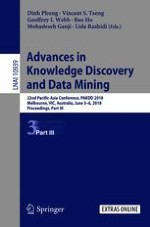2018 | Book
Advances in Knowledge Discovery and Data Mining
22nd Pacific-Asia Conference, PAKDD 2018, Melbourne, VIC, Australia, June 3-6, 2018, Proceedings, Part III
Editors: Dinh Phung, Vincent S. Tseng, Prof. Geoffrey I. Webb, Bao Ho, Mohadeseh Ganji, Lida Rashidi
Publisher: Springer International Publishing
Book Series : Lecture Notes in Computer Science
